The Saint of the Day
 |
 |
 |
 |
 |
 |
 |
St. Germain of Auxerre - July 31
Biographical selection:
St. Germain, born into one of the most noble families in Gaul, was the Bishop of the French Diocese of Auxerre in the 5th century. He was sent as a missionary to England around 429 to combat the errors of the Pelagians. He zealously confirmed the Catholics in the True Faith and converted the heretics, preaching often in the highways and fields when the churches were not able to contain the crowds that flocked to hear him.
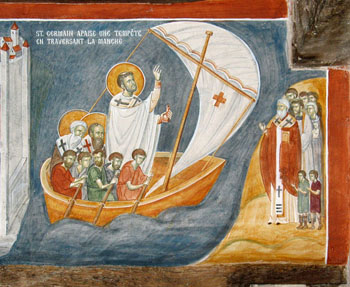 Two barbarian peoples – the Picts and the Saxons – had invaded Great Britain and were making raids on the native Britons. St. Germain did not hesitate to take up the sword and assume the role of commander-in-chief of the Anglos at a mountainous site near a river in Mould (North Wales). As the enemy approached, St. Germain launched his warriors against them, leading them to a valley between two high mountains. There he ordered his men to shout out the war cry "Halleluiah!" when he gave the sign.
Two barbarian peoples – the Picts and the Saxons – had invaded Great Britain and were making raids on the native Britons. St. Germain did not hesitate to take up the sword and assume the role of commander-in-chief of the Anglos at a mountainous site near a river in Mould (North Wales). As the enemy approached, St. Germain launched his warriors against them, leading them to a valley between two high mountains. There he ordered his men to shout out the war cry "Halleluiah!" when he gave the sign.
The sound echoed from the hills with a noise so loud that the barbarians believed they would face a mighty army. In panic, they flung down their arms and ran. Many of them were drowned in the river as they madly rushed to cross it. The others fell under the swords of the soldiers of St. Germain.
One time, Eocarich, a barbarian King, was sent to subdue the people of Armorica, or Brittany, to punish them for a recent revolt, The Saint agreed to be their protector. St. Germain boldly accosted the barbarian to stop the expedition.
Eocarich angrily gestured for the Saint to move out of his way. Taking the chief's horse by the bridle, St. Germain loudly cried out: "You will pass over my dead body, O King of the Alemannis, or you will hear my words, because I speak to you in the name of Christ, the King of Heaven."
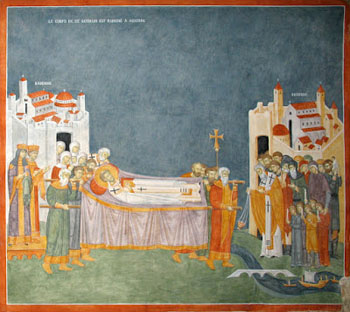 The King, impressed with the supernatural majesty of the Bishop, dismounted, listened to his words and agreed to call off his troops and not to ravage the province.
The King, impressed with the supernatural majesty of the Bishop, dismounted, listened to his words and agreed to call off his troops and not to ravage the province.
Once when he was in Autun, St. Germain – followed by the people – went to the tomb of the Holy Bishop Cassian. After praying for a long time, he said: "Glorious brother, what do you do in your sepulcher?"
From inside the tomb came a voice answering: "I rest in the peace of the Lord and I await the coming of my Redeemer."
St. Germain replied: "My brother, rest in this sepulcher for as long a time as it pleases Christ Jesus. Farewell, until the end of the world. Pray for my people and for me, so that we may deserve the glory of a happy resurrection."
St Germain died in Ravenna on the last day of July in the year 448, have held his see 30 years and 25 days.
Comments of Prof. Plinio:
The 5th century was the century of the great invasions. The Roman Empire of the West was devastated by the attacks of the Barbarians after they crossed the Rhine and the Danube and covered all of Western Europe. It was a century of affliction for the Church because, along with the many Barbarians who were pagans, others were Arians.
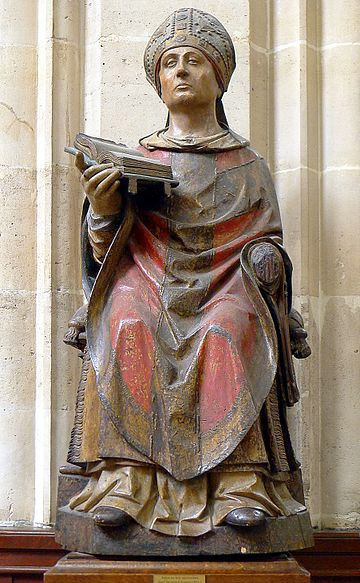 Arianism was a heresy that rose one century earlier and was spread among the Barbarians by a bishop called Ulfilas. He influenced a great number of the invaders to have a mortal hatred for the Catholic Church. The barbarian invasion was a disaster for the Church. It was an invasion of pagans and heretics who wanted to tear down the Catholic Latin Empire. Further, it was an invasion of persons without any civilization, who broke the structures of Roman Civilization upon which Christianity had left its mark.
Arianism was a heresy that rose one century earlier and was spread among the Barbarians by a bishop called Ulfilas. He influenced a great number of the invaders to have a mortal hatred for the Catholic Church. The barbarian invasion was a disaster for the Church. It was an invasion of pagans and heretics who wanted to tear down the Catholic Latin Empire. Further, it was an invasion of persons without any civilization, who broke the structures of Roman Civilization upon which Christianity had left its mark.
Then, Divine Providence raised up a series of great saints to whom It confided the task of transforming that setback into one of the greatest triumphs in History.
The Roman Empire of the West was rotten. It final destruction, which could have been something bad, was a good thing in the sense that the rottenness of the Empire disappeared with it. But the structure of the Church remained.
That structure, tested and proved by many sufferings and victories over the contaminations of the decadent Empire, was in conditions to face the Barbarians. Great saints, men of Faith, miracle workers, men who did extraordinary works faced the Barbarians and converted them. At the same time, they communicated the remnants of Latin culture to the Barbarians.
From this intermingling of barbarian elements, Latin culture and, above all, the Catholic Faith came the most extraordinary synthesis that History has known: the Middle Ages. It was the decadence of the Middle Ages that marked the beginning of the Revolution.
Now then, the Reign of Mary will be a new Middle Ages that will be born from the mysterious convulsions predicted at Fatima. At a certain moment those convulsions will destroy the remains of Western and Eastern civilizations and the world will suffer the chastisements predicted in Fatima.
There is a fecund analogy between the saints who lived at the end of the Western Roman Empire and witnessed the dawn of the Middle Ages and the men who will see the end of the Western Civilization in our times and the birth of the Reign of Mary. They should imitate those saints.
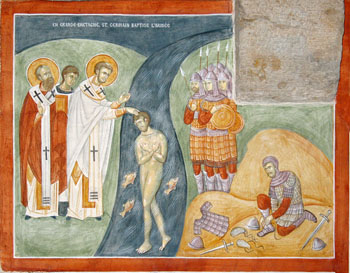 This similarity causes us to have a special interest in the saints of that epoch. One of those saints was St. Germain of Auxerre.
This similarity causes us to have a special interest in the saints of that epoch. One of those saints was St. Germain of Auxerre.
The selection shows us some incidents from the life of St. Germain that we should transport to our time to measure the differences.
We see that the description paints a not-very-canonical figure of St. Germain, but a very breathtaking portrait of a great saint: a Bishop and at the same time a warrior. Why is he not a very canonical figure? It is because Canon Law, with that wisdom that characterizes the Church, later established that those who represent Christ – principally the Bishops who are the successors of the Apostles – should not shed human blood. They can only do so in the legitimate defense of their own lives.
The rule was made not because fighting is immoral, but rather as matter of convenience, a question of congruence. It is not convenient for a representative of Christ to engage in violent action that could cause the death of another. This is why the Church recommends that the priest not enter into battle.
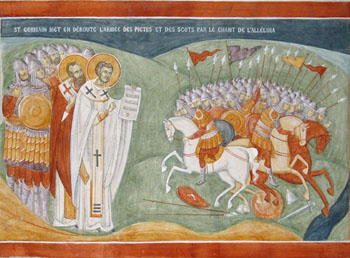 But at the time of St. Germain, Canon Law did not forbid bishops from going to war. The times were dominated by the invasion of the Barbarians, who considered it absolutely normal to kill. So then, you have the venerable figure of St. Germain who, sword in hand, leads the Britons to defend themselves against those who invaded their territory.
But at the time of St. Germain, Canon Law did not forbid bishops from going to war. The times were dominated by the invasion of the Barbarians, who considered it absolutely normal to kill. So then, you have the venerable figure of St. Germain who, sword in hand, leads the Britons to defend themselves against those who invaded their territory.
For us, who are exhausted from seeing so many concessions made by the Hierarchy, exhausted from witnessing so much softness and so many retreats, this description raises our enthusiasm. If I were to see a Bishop sword in hand leading the fight, I would follow him and call upon others to join us.
St. Germain used to do this. Those Barbarians were very primitive. St. Germain was a civilized man. He could lead the people to battle not because he was a trained military man, but because he had a higher intelligence and could judge the way to counter-attack the invader. Doing so, he spared many lives.
So, St. Germain was on one side of the river near Mould attacking those Barbarians who were crossing the river and made a brilliant maneuver. In this way he won a great victory. This is a first 'flash' of St. Germain's life and work.
Another episode describes that Bishop, who did not hesitate to lead the fight, now appearing as an apostle of the peace, preventing a Barbarian King from taking a violent and perhaps unjust action. The Saint took the reins of the King's horse and would not let him proceed.
That King, not at all a civilized King but a savage accustomed to all types of violence, was impressed by the majesty of St. Germain and the solemnity with which he spoke in the name of Jesus Christ, the King of Heaven.
The savage dismounted, set aside his arms, and most likely said something like this: "Father, what do you want me to do?"
The Saint sat down with him and spoke. He won the battle.
It is a beautiful episode that shows the supremacy of the supernatural over the natural, the spiritual over the material, virtue over wrongdoing.
Another episode recounts the visit of St. Germain to the sepulcher of a holy Bishop, St. Cassian. St. Germain asked the Bishop what he was doing after his death.
The question has a simplicity that shocks the modern mentality, but at that time things like this happened as a guerdon God used to give to men of Faith.
Then, from the tomb came the voice of St. Cassian, who answered that he was awaiting his resurrection and the second coming of Christ. It is a beautiful lesson on the immortality of the soul and the reward God gives to the good, with the corollary punishment for the bad.
Then, St. Germain bade him farewell and went away.
You can imagine the scene after this dialogue: St. Germain leaving the cemetery deep in thought, and the little people who had watched it commenting among themselves on this extraordinary episode. You see how the Faith was ingrained in the very depths of those souls and was forming the roots of what would become the Middle Ages.
 You may say to me: All these facts are very beautiful, but how do they relate to our times?
You may say to me: All these facts are very beautiful, but how do they relate to our times?
First, consider that decadent peoples are indifferent to miracles. So were the Romans. So are most of contemporary men. These people represent the dusk. The miracles come to cultivate the peoples who are in the dawn of their spiritual life. At the time of St. Germain, God was preparing a new era. Today, people do not believe in miracles. We need only consider Lourdes or Fatima: Who changed their lives because of the miracles worked there? Practically no one.
A great chastisement is necessary to purify mankind and wipe out the exponents of evil whose influence holds men in the Devil's claws. Those who will remain will be those capable of returning to innocence and simplicity. They will be assisted by miracles.


The Saint of the Day features highlights from the lives of saints based on comments made by the late Prof. Plinio Corrêa de Oliveira. Following the example of St. John Bosco who used to make similar talks for the boys of his College, each evening it was Prof. Plinio’s custom to make a short commentary on the lives of the next day’s saint in a meeting for youth in order to encourage them in the practice of virtue and love for the Catholic Church. TIA thought that its readers could profit from these valuable commentaries.
The texts of both the biographical data and the comments come from personal notes taken by Atila S. Guimarães from 1964 to 1995. Given the fact that the source is a personal notebook, it is possible that at times the biographic notes transcribed here will not rigorously follow the original text read by Prof. Plinio. The commentaries have also been adapted and translated for TIA’s site.
St. Germain, born into one of the most noble families in Gaul, was the Bishop of the French Diocese of Auxerre in the 5th century. He was sent as a missionary to England around 429 to combat the errors of the Pelagians. He zealously confirmed the Catholics in the True Faith and converted the heretics, preaching often in the highways and fields when the churches were not able to contain the crowds that flocked to hear him.

St. Germain travels to England to combat the Pelagians
The sound echoed from the hills with a noise so loud that the barbarians believed they would face a mighty army. In panic, they flung down their arms and ran. Many of them were drowned in the river as they madly rushed to cross it. The others fell under the swords of the soldiers of St. Germain.
One time, Eocarich, a barbarian King, was sent to subdue the people of Armorica, or Brittany, to punish them for a recent revolt, The Saint agreed to be their protector. St. Germain boldly accosted the barbarian to stop the expedition.
Eocarich angrily gestured for the Saint to move out of his way. Taking the chief's horse by the bridle, St. Germain loudly cried out: "You will pass over my dead body, O King of the Alemannis, or you will hear my words, because I speak to you in the name of Christ, the King of Heaven."

The funeral of St. Germain in Ravenna
Once when he was in Autun, St. Germain – followed by the people – went to the tomb of the Holy Bishop Cassian. After praying for a long time, he said: "Glorious brother, what do you do in your sepulcher?"
From inside the tomb came a voice answering: "I rest in the peace of the Lord and I await the coming of my Redeemer."
St. Germain replied: "My brother, rest in this sepulcher for as long a time as it pleases Christ Jesus. Farewell, until the end of the world. Pray for my people and for me, so that we may deserve the glory of a happy resurrection."
St Germain died in Ravenna on the last day of July in the year 448, have held his see 30 years and 25 days.
Comments of Prof. Plinio:
The 5th century was the century of the great invasions. The Roman Empire of the West was devastated by the attacks of the Barbarians after they crossed the Rhine and the Danube and covered all of Western Europe. It was a century of affliction for the Church because, along with the many Barbarians who were pagans, others were Arians.

St. Germain at Saint-Germain l’Auxerrois Church in Paris
Then, Divine Providence raised up a series of great saints to whom It confided the task of transforming that setback into one of the greatest triumphs in History.
The Roman Empire of the West was rotten. It final destruction, which could have been something bad, was a good thing in the sense that the rottenness of the Empire disappeared with it. But the structure of the Church remained.
That structure, tested and proved by many sufferings and victories over the contaminations of the decadent Empire, was in conditions to face the Barbarians. Great saints, men of Faith, miracle workers, men who did extraordinary works faced the Barbarians and converted them. At the same time, they communicated the remnants of Latin culture to the Barbarians.
From this intermingling of barbarian elements, Latin culture and, above all, the Catholic Faith came the most extraordinary synthesis that History has known: the Middle Ages. It was the decadence of the Middle Ages that marked the beginning of the Revolution.
Now then, the Reign of Mary will be a new Middle Ages that will be born from the mysterious convulsions predicted at Fatima. At a certain moment those convulsions will destroy the remains of Western and Eastern civilizations and the world will suffer the chastisements predicted in Fatima.
There is a fecund analogy between the saints who lived at the end of the Western Roman Empire and witnessed the dawn of the Middle Ages and the men who will see the end of the Western Civilization in our times and the birth of the Reign of Mary. They should imitate those saints.

After preaching & working miracles, St. Germain baptizes many Roman soldiers
The selection shows us some incidents from the life of St. Germain that we should transport to our time to measure the differences.
We see that the description paints a not-very-canonical figure of St. Germain, but a very breathtaking portrait of a great saint: a Bishop and at the same time a warrior. Why is he not a very canonical figure? It is because Canon Law, with that wisdom that characterizes the Church, later established that those who represent Christ – principally the Bishops who are the successors of the Apostles – should not shed human blood. They can only do so in the legitimate defense of their own lives.
The rule was made not because fighting is immoral, but rather as matter of convenience, a question of congruence. It is not convenient for a representative of Christ to engage in violent action that could cause the death of another. This is why the Church recommends that the priest not enter into battle.

St. Germain agrees to lead the soldiers in a battle
For us, who are exhausted from seeing so many concessions made by the Hierarchy, exhausted from witnessing so much softness and so many retreats, this description raises our enthusiasm. If I were to see a Bishop sword in hand leading the fight, I would follow him and call upon others to join us.
St. Germain used to do this. Those Barbarians were very primitive. St. Germain was a civilized man. He could lead the people to battle not because he was a trained military man, but because he had a higher intelligence and could judge the way to counter-attack the invader. Doing so, he spared many lives.
So, St. Germain was on one side of the river near Mould attacking those Barbarians who were crossing the river and made a brilliant maneuver. In this way he won a great victory. This is a first 'flash' of St. Germain's life and work.
Another episode describes that Bishop, who did not hesitate to lead the fight, now appearing as an apostle of the peace, preventing a Barbarian King from taking a violent and perhaps unjust action. The Saint took the reins of the King's horse and would not let him proceed.
That King, not at all a civilized King but a savage accustomed to all types of violence, was impressed by the majesty of St. Germain and the solemnity with which he spoke in the name of Jesus Christ, the King of Heaven.
The savage dismounted, set aside his arms, and most likely said something like this: "Father, what do you want me to do?"
The Saint sat down with him and spoke. He won the battle.
It is a beautiful episode that shows the supremacy of the supernatural over the natural, the spiritual over the material, virtue over wrongdoing.
Another episode recounts the visit of St. Germain to the sepulcher of a holy Bishop, St. Cassian. St. Germain asked the Bishop what he was doing after his death.
The question has a simplicity that shocks the modern mentality, but at that time things like this happened as a guerdon God used to give to men of Faith.
Then, from the tomb came the voice of St. Cassian, who answered that he was awaiting his resurrection and the second coming of Christ. It is a beautiful lesson on the immortality of the soul and the reward God gives to the good, with the corollary punishment for the bad.
Then, St. Germain bade him farewell and went away.
You can imagine the scene after this dialogue: St. Germain leaving the cemetery deep in thought, and the little people who had watched it commenting among themselves on this extraordinary episode. You see how the Faith was ingrained in the very depths of those souls and was forming the roots of what would become the Middle Ages.

A new dawn will rise with many miracles to usher in the Reign of Mary
First, consider that decadent peoples are indifferent to miracles. So were the Romans. So are most of contemporary men. These people represent the dusk. The miracles come to cultivate the peoples who are in the dawn of their spiritual life. At the time of St. Germain, God was preparing a new era. Today, people do not believe in miracles. We need only consider Lourdes or Fatima: Who changed their lives because of the miracles worked there? Practically no one.
A great chastisement is necessary to purify mankind and wipe out the exponents of evil whose influence holds men in the Devil's claws. Those who will remain will be those capable of returning to innocence and simplicity. They will be assisted by miracles.

 | |
|
|
The texts of both the biographical data and the comments come from personal notes taken by Atila S. Guimarães from 1964 to 1995. Given the fact that the source is a personal notebook, it is possible that at times the biographic notes transcribed here will not rigorously follow the original text read by Prof. Plinio. The commentaries have also been adapted and translated for TIA’s site.


